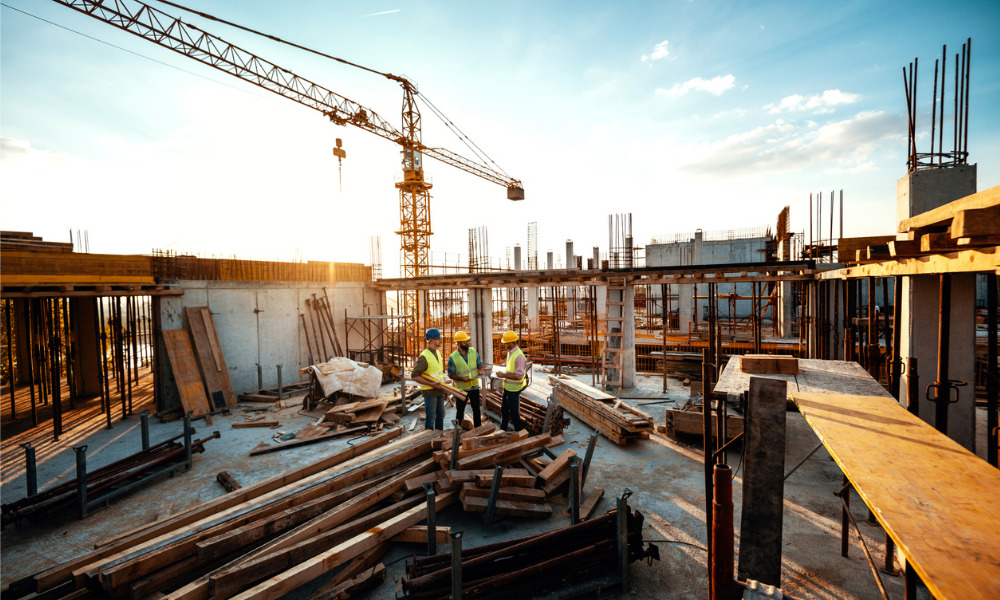Although there may have been some hesitancy in moving infrastructure projects forward in the first few months of the COVID-19 pandemic, those fears have now largely faded, and there’s money to be invested by governments and the private sector.
“Procuring authorities paused, in the initial three or four months of the pandemic; there were a lot of projects that got put on hold” as players tried to figure out what the pandemic would look like, says Timothy Murphy, a partner in project finance and P3 at McMillan LLP in Toronto.
Now, though, as pandemic restrictions begin to ease and society returns to normal, “people are looking to how they boost the economy, and infrastructure continues to be one of those significant ways.”
Governments in Canada as well as in the U.S. are recognizing they must address the infrastructure deficit, says William Jenkins, who co-leads Dentons Canada LLP’s Banking and Financial Services practice group in Calgary. In addition, the pandemic’s depressing effects on the economy have encouraged government spending to boost it.
Indeed, in October Prime Minister Justin Trudeau announced $10 billion in new major infrastructure initiatives to create approximately 60,000 jobs and economic growth. The three-year plan of the Canada Infrastructure Bank (CIB) is to connect more households and small businesses to high-speed Internet, strengthen Canadian agriculture, and help build a low-carbon economy.
And in its 2021 Statement of Priorities and Accountabilities, published in June, the CIB said it aimed to “urgently address the Indigenous infrastructure deficit” with a new investment target of $1 billion for Indigenous infrastructure projects across the CIB’s five priority areas: public transit, clean power, green infrastructure, broadband, and trade and transport.
The increased investment is “a happy confluence of both” the need for infrastructure and supporting the economy, says Jenkins.
There is also continued interest in the Canadian marketplace, Murphy says, with foreign banks and contractors coming into Canada more in the past few years.
Financing parties whose mandates may have been limited when the pandemic started are “all back in the market looking for deals,” says Aaron Fransen, a partner in Stikeman Elliott LLP in Toronto. “There’s more capital to be deployed than there are deals, and it’s a matter of bringing the deals to market.“
What government is financing now
Three broad categories that governments are and will be financing, says Murphy, are transit and transportation; health care; and climate change and adaption.
In Ontario, the transportation investment includes the multimillion-dollar GO Transit Regional Express Rail, aka the GO Expansion line.
In the health-care sector, there may be “slightly less traditional structures” as health care provision, including in long-term care facilities, is reconsidered, he says.
In the climate change and adaptation category, the CIB is a significant investor in energy retrofits and zero-emission projects. There is also investment in “transitional infrastructure,” related to how to move from oil and gas to a greener economy
Investors are very keen to employ capital, from private equity to all levels of debt, in energy infrastructure as the sector transitions to a green economy, says Fransen, who has worked on financing solar and wind projects in the past few years. It’s not only Hydro One in Ontario that has used its lines to transmit electricity generated by wind and solar; other companies have also gotten into it, he says. “Greening the grid” and moving to a carbon economy, including carbon storage and capture technologies, has a lot of private sector interest as well as being supported by the CIB.
Although hospitals, roads and other social infrastructure are still being built, focus has shifted “to the infrastructure that supports … the country’s climate objectives and other environmental objectives,” Fransen adds. “There seems to be a lot of capital being deployed [there] in the last year or so.”
Indigenous infrastructure and ownership
Greening the grid has dovetailed with the interests of First Nations, who are increasingly taking significant ownership stakes in infrastructure projects.
A number of First Nations and northern Ontario communities have a 20-per-cent stake, Fransen says, in the East-West Tie Transmission Project: an approximately 450-kilometer, double-circuit, 230-kilovolt transmission line from the Wawa Transformer Station to the Lakehead Transformer Station near Thunder Bay. Its proponent is NextBridge Infrastructure LP.
Further south in Ontario, the Oneida Energy Storage project is a joint venture between NRStor Inc. and Six Nations of the Grand River Development Corporation to develop a 250 megawatt/1000 megawatt-hour energy storage facility.
“These aren’t small stakes,” says Fransen; First Nations are “significant players at the table on all these transactions,” in particular in power generation and storage projects, and who are involved in the structuring and development of projects. “Banks are very keen to do those deals, and the law firms are obviously very keen to support [First Nations] in doing those deals.”
The big law firms representing these deals are proof of their magnitude. Stikeman Elliott represented the 51-per-cent ownership interest of 24 First Nations in the Wataynikaneyap Power Transmission Project deal, which will supply clean, reliable energy to thousands of residents across the region and eliminate the financially unsustainable and environmentally dangerous reliance on diesel generation. The total project cost is anticipated to be upwards of $1.9 billion, with the project targeted for completion by the end of 2023.
“You see a lot of the kind of the firms that have more traditionally acted for banks and developers acting for the First Nations communities in those kind of deals, just because the nature of support they need is different than what it’s been in the past,” Fransen says.
COVID’s effect on financing and execution
Although the COVID-19 pandemic may ultimately provide a stimulus through increased government spending, it has also cost infrastructure projects.
Commodities such as lumber have become more expensive, and “when you’re doing the kind of project that is going to be financed, there’s a tremendous premium on cost certainty and being able to accurately predict the costs,” says Jenkins. “In an environment where cost is moving up and down more quickly, it’s harder for people to have confidence in their pricing estimates. So, there’s caution [now] in green-lining new projects, but ideally that will soon no longer be case.”
COVID has created added costs due to higher materials prices, necessary safety precautions and delays. For example, the Heartland Petrochemical Complex -- Inter Pipeline’s $3.5-billion project in Fort Saskatchewan, Alta. that will produce recyclable plastics from the province’s propane -- kept costs to a minimum and stayed on schedule, but the pandemic still added about five per cent to the cost of the project, Jenkins says.
The impact of the COVID-19 pandemic on Toronto’s Eglinton Crosstown LRT Project construction schedule also gave a private partner in the project entitlement to forward a relief claim under the emergency provisions of the project agreement. In May Justice Markus Koehnen of the Ontario Superior Court ruled that Crosslinx Transit Solutions could seek relief from Ontario Infrastructure and Lands Corporation.
The decision in Crosslinx v. Ontario Infrastructure hinged on the wording of the project agreement and notably found that “the pandemic was self-evidently an emergency,” says Murphy. “You can’t consider a global pandemic as a normal risk allocation.” The judge concluded that the government was too aggressive in pushing this risk to the private sector, which “feeds back into the whole debate about putting partnership back into public-private partnership,” he adds.
“There were construction contractors and others who weren’t bidding on projects, some bankruptcies in the sector, but also people who were withdrawing because they viewed the risk allocation as too aggressive.”
Both public authorities and the private sector are looking at more innovative contracting models, Murphy adds, such as Progressive Design-Build and alliance contracting, “as ways of better managing the risks in a project that generates both value for money for the authority, but also more tolerable risk allocation for the private sector.”
It will only get better
As the economy transitions back to a more normal state, it’s likely that project financing will accelerate due to pent-up demand and the availability of capital, says Jenkins, “and we’ll get back to a market where many projects are being actively pursued.”
There continues to be “lots of money looking for places to invest, and governments continue to be a pretty good bet on risk,” Murphy says.
“While they may fuss on details, there’s lots of money still looking to invest in private-sector participation in infrastructure projects,” and lots of lenders still willing to lend, he adds. The good news is that, to date, “the price of money is still pretty good,” though over time there’ll need to be an eye on inflation, which will press up interest costs.
“But so far there’s still a lot of interest in good pricing, and from the public side, there’s still a lot of investment in infrastructure and -- to be honest with you -- not a lot of sign that it’s going to stop anytime” soon.





